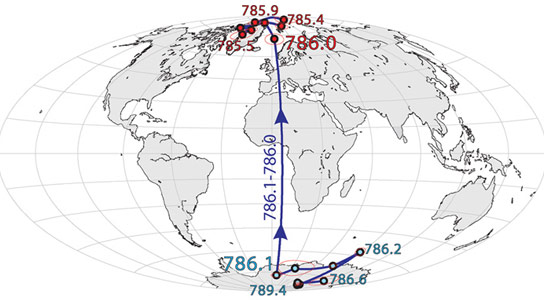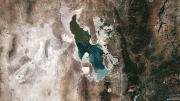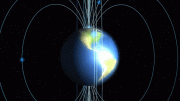
The ‘north pole’ — that is, the direction of magnetic north — was reversed a million years ago. This map shows how, starting about 789,000 years ago, the north pole wandered around Antarctica for several thousand years before flipping 786,000 years ago to the orientation we know today, with the pole somewhere in the Arctic. Credit: UC Berkeley News
Earth’s magnetic field is decreasing 10 times faster than normal, leading some geophysicists to predict a magnetic reversal to occur within a few thousand years. New research from an international team of scientists shows that this reversal could happen over a short period of time – less than a hundred years.
Berkeley — Imagine the world waking up one morning to discover that all compasses pointed south instead of north.
It’s not as bizarre as it sounds. Earth’s magnetic field has flipped – though not overnight – many times throughout the planet’s history. Its dipole magnetic field, like that of a bar magnet, remains about the same intensity for thousands to millions of years, but for incompletely known reasons it occasionally weakens and, presumably over a few thousand years, reverses direction.
Now, a new study by a team of scientists from Italy, France, Columbia University, and the University of California, Berkeley, demonstrates that the last magnetic reversal was 786,000 years ago actually – roughly a human lifetime.
“It’s amazing how rapidly we see that reversal,” said UC Berkeley graduate student Courtney Sprain. “The paleomagnetic data are very well done. This is one of the best records we have so far of what happens during a reversal and how quickly these reversals can happen.”
Sprain and Paul Renne, director of the Berkeley Geochronology Center and a UC Berkeley professor-in-residence of earth and planetary science, are coauthors of the study, which is published in the November issue of Geophysical Journal International.
Flip could affect electrical grid, cancer rates
The discovery comes as new evidence indicates that the intensity of Earth’s magnetic field is decreasing 10 times faster than normal, leading some geophysicists to predict a reversal within a few thousand years.
Though a magnetic reversal is a major planet-wide event driven by convection in Earth’s iron core, there are no documented catastrophes associated with past reversals, despite much searching in the geologic and biologic record. Today, however, such a reversal could potentially wreak havoc with our electrical grid, generating currents that might take it down.
And since Earth’s magnetic field protects life from energetic particles from the sun and cosmic rays, both of which can cause genetic mutations, a weakening or temporary loss of the field before a permanent reversal could increase cancer rates. The danger to life would be even greater if flips were preceded by long periods of unstable magnetic behavior.
“We should be thinking more about what the biologic effects would be,” Renne said.
Dating ash deposits from windward volcanoes
The new finding is based on measurements of the magnetic field alignment in layers of ancient lake sediments now exposed in the Sulmona basin of the Apennine Mountains east of Rome, Italy. The lake sediments are interbedded with ash layers erupted from the Roman volcanic province, a large area of volcanoes upwind of the former lake that includes periodically erupting volcanoes near Sabatini, Vesuvius, and the Alban Hills.
Italian researchers led by Leonardo Sagnotti of Rome’s National Institute of Geophysics and Volcanology measured the magnetic field directions frozen into the sediments as they accumulated at the bottom of the ancient lake.
Sprain and Renne used argon-argon dating, a method widely used to determine the ages of rocks, whether they’re thousands or billions of years old, to determine the age of ash layers above and below the sediment layer recording the last reversal. These dates were confirmed by their colleague and former UC Berkeley postdoctoral fellow Sebastien Nomade of the Laboratory of Environmental and Climate Sciences in Gif-Sur-Yvette, France.
Because the lake sediments were deposited at a high and steady rate over a 10,000-year period, the team was able to interpolate the date of the layer showing the magnetic reversal, called the Matuyama-Brunhes transition, at approximately 786,000 years ago. This date is far more precise than that from previous studies, which placed the reversal between 770,000 and 795,000 years ago.
“What’s incredible is that you go from reverse polarity to a field that is normal with essentially nothing in between, which means it had to have happened very quickly, probably in less than 100 years,” said Renne. “We don’t know whether the next reversal will occur as suddenly as this one did, but we also don’t know that it won’t.”
Unstable magnetic field preceded 180-degree flip
Whether or not the new finding spells trouble for modern civilization, it likely will help researchers understand how and why Earth’s magnetic field episodically reverses polarity, Renne said.
The magnetic record the Italian-led team obtained shows that the sudden 180-degree flip of the field was preceded by a period of instability that spanned more than 6,000 years. The instability included two intervals of low magnetic field strength that lasted about 2,000 years each. Rapid changes in field orientations may have occurred within the first interval of low strength. The full magnetic polarity reversal – that is, the final and very rapid flip to what the field is today – happened toward the end of the most recent interval of low field strength.
Renne is continuing his collaboration with the Italian-French team to correlate the lake record with past climate change.
Renne and Sprain’s work at the Berkeley Geochronology Center was supported by the Ann and Gordon Getty Foundation.
Reference: “Extremely rapid directional change during Matuyama-Brunhes geomagnetic polarity reversal” by Leonardo Sagnotti, Giancarlo Scardia, Biagio Giaccio, Joseph C. Liddicoat, Sebastien Nomade, Paul R. Renne and Courtney J. Sprain, 18 September 2014, Geophysical Journal International.
DOI: 10.1093/gji/ggu287









“Today, however, such a reversal could potentially wreak havoc with our electrical grid, generating currents that might take it down.”
“What’s incredible is that you go from reverse polarity to a field that is normal with essentially nothing in between, which means it had to have happened very quickly, probably in less than 100 years,”
“The magnetic record the Italian-led team obtained shows that the sudden 180-degree flip of the field was preceded by a period of instability that spanned more than 6,000 years.”
The calamitous tone of the language in this report in respect of damage to the Earth’s electrical grids is entirely unwarranted, considering that:
(a) We seem to be entering a period of magnetic field instability
(b) But that period of instability appears by the past record to last around 6000 years, after which the grids are unlikely still to exist, unless we change our warlike ways, and
(c) Catastrophic damage to the grid could be expected if the flip happened truly overnight – but in this case “overnight” in geological terms amounts to around 100 years, during which the grids – if they still existed – could gradually acclimatize themselves to the new situation.
Please report the facts sensibly.
Tony,
You’re making the assumption that our political and business leaders will take action on something that is decades away “until” it happens. Given our history, I would say the author isn’t too far from the truth. While we do have the capability to buffer our systems, I don’t see most countries preparing for the inevitable…
Does the reversal rotate the poles to their new position or just gradually weaken to zero and then gradually strengthen in the opposite direction?
The magnetic flip from North to South or for that matter from South to North may not make any difference, as long as the earth`s magnetic field intensity remains the same. The magnetic intensity though reducing slowly may not take a drastic change. After all North Pole and South Pole are arbitrarily fixed by us and we will just label them otherwise. The flip may not be sudden however, but only gradual over a million years. Even now the Dip and Declination of a magnetic compass shows that it is vulnerable for a change over a long period of time at any given point on earth.The magnetic intensity of earth is due to an ionic core which is rotating in the hollow sphere with currents throwing magnetic intensity on the surface and magnetizing Fe,Co,and Ni like ferro-magnetic material embedded beneath the surface. MOreover, every spherical body in the Universe is bound to be hollow at the centre with hot ionic gases and thus be having magnetic field. Thus, Moon, Mars or other planets are bound to be magnetic. The Sun which is whole sphere of ionization of Hydrogen, Helium and other elements should be very highly magnetic above all thus throwing magnetic storms and solar flares, which we see as black sunspots from Galelio`s time.Thank You.